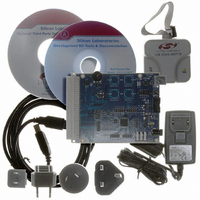C8051F700DK Silicon Laboratories Inc, C8051F700DK Datasheet - Page 235

C8051F700DK
Manufacturer Part Number
C8051F700DK
Description
DEV KIT FOR C8051F700
Manufacturer
Silicon Laboratories Inc
Type
MCUr
Datasheets
1.C8051F700-TB.pdf
(1 pages)
2.C8051F700-TB.pdf
(306 pages)
3.C8051F700-TB.pdf
(18 pages)
Specifications of C8051F700DK
Contents
Board, Cables, CD, Debugger, Power Supply
Processor To Be Evaluated
C8051F7x
Processor Series
C8051F7xx
Interface Type
USB
Operating Supply Voltage
3.3 V
Lead Free Status / RoHS Status
Lead free / RoHS Compliant
For Use With/related Products
C8051F7xx
Lead Free Status / Rohs Status
Lead free / RoHS Compliant
Other names
336-1635
- Current page: 235 of 306
- Download datasheet (2Mb)
30.5.4. Read Sequence (Slave)
During a read sequence, an SMBus master reads data from a slave device. The slave in this transfer will
be a receiver during the address byte, and a transmitter during all data bytes. When slave events are
enabled (INH = 0), the interface enters Slave Receiver Mode (to receive the slave address) when a START
followed by a slave address and direction bit (READ in this case) is received. If hardware ACK generation
is disabled, upon entering Slave Receiver Mode, an interrupt is generated and the ACKRQ bit is set. The
software must respond to the received slave address with an ACK, or ignore the received slave address
with a NACK. If hardware ACK generation is enabled, the hardware will apply the ACK for a slave address
which matches the criteria set up by SMB0ADR and SMB0ADM. The interrupt will occur after the ACK
cycle.
If the received slave address is ignored (by software or hardware), slave interrupts will be inhibited until the
next START is detected. If the received slave address is acknowledged, zero or more data bytes are trans-
mitted. If the received slave address is acknowledged, data should be written to SMB0DAT to be transmit-
ted. The interface enters slave transmitter mode, and transmits one or more bytes of data. After each byte
is transmitted, the master sends an acknowledge bit; if the acknowledge bit is an ACK, SMB0DAT should
be written with the next data byte. If the acknowledge bit is a NACK, SMB0DAT should not be written to
before SI is cleared (an error condition may be generated if SMB0DAT is written following a received
NACK while in slave transmitter mode). The interface exits slave transmitter mode after receiving a STOP.
The interface will switch to slave receiver mode if SMB0DAT is not written following a Slave Transmitter
interrupt. Figure 30.8 shows a typical slave read sequence. Two transmitted data bytes are shown, though
any number of bytes may be transmitted. Notice that all of the “data byte transferred” interrupts occur after
the ACK cycle in this mode, regardless of whether hardware ACK generation is enabled.
30.6. SMBus Status Decoding
The current SMBus status can be easily decoded using the SMB0CN register. The appropriate actions to
take in response to an SMBus event depend on whether hardware slave address recognition and ACK
generation is enabled or disabled. Table 30.5 describes the typical actions when hardware slave address
recognition and ACK generation is disabled. Table 30.6 describes the typical actions when hardware slave
address recognition and ACK generation is enabled. In the tables, STATUS VECTOR refers to the four
upper bits of SMB0CN: MASTER, TXMODE, STA, and STO. The shown response options are only the typ-
ical responses; application-specific procedures are allowed as long as they conform to the SMBus specifi-
cation. Highlighted responses are allowed by hardware but do not conform to the SMBus specification.
S
Received by SMBus
Interface
Transmitted by
SMBus Interface
SLA
Figure 30.8. Typical Slave Read Sequence
R
A
Interrupts with Hardware ACK Disabled (EHACK = 0)
Interrupts with Hardware ACK Enabled (EHACK = 1)
Data Byte
Rev. 1.0
A
S = START
P = STOP
N = NACK
R = READ
SLA = Slave Address
Data Byte
C8051F70x/71x
N
P
235
Related parts for C8051F700DK
Image
Part Number
Description
Manufacturer
Datasheet
Request
R
Part Number:
Description:
SMD/C°/SINGLE-ENDED OUTPUT SILICON OSCILLATOR
Manufacturer:
Silicon Laboratories Inc
Part Number:
Description:
Manufacturer:
Silicon Laboratories Inc
Datasheet:
Part Number:
Description:
N/A N/A/SI4010 AES KEYFOB DEMO WITH LCD RX
Manufacturer:
Silicon Laboratories Inc
Datasheet:
Part Number:
Description:
N/A N/A/SI4010 SIMPLIFIED KEY FOB DEMO WITH LED RX
Manufacturer:
Silicon Laboratories Inc
Datasheet:
Part Number:
Description:
N/A/-40 TO 85 OC/EZLINK MODULE; F930/4432 HIGH BAND (REV E/B1)
Manufacturer:
Silicon Laboratories Inc
Part Number:
Description:
EZLink Module; F930/4432 Low Band (rev e/B1)
Manufacturer:
Silicon Laboratories Inc
Part Number:
Description:
I°/4460 10 DBM RADIO TEST CARD 434 MHZ
Manufacturer:
Silicon Laboratories Inc
Part Number:
Description:
I°/4461 14 DBM RADIO TEST CARD 868 MHZ
Manufacturer:
Silicon Laboratories Inc
Part Number:
Description:
I°/4463 20 DBM RFSWITCH RADIO TEST CARD 460 MHZ
Manufacturer:
Silicon Laboratories Inc
Part Number:
Description:
I°/4463 20 DBM RADIO TEST CARD 868 MHZ
Manufacturer:
Silicon Laboratories Inc
Part Number:
Description:
I°/4463 27 DBM RADIO TEST CARD 868 MHZ
Manufacturer:
Silicon Laboratories Inc
Part Number:
Description:
I°/4463 SKYWORKS 30 DBM RADIO TEST CARD 915 MHZ
Manufacturer:
Silicon Laboratories Inc
Part Number:
Description:
N/A N/A/-40 TO 85 OC/4463 RFMD 30 DBM RADIO TEST CARD 915 MHZ
Manufacturer:
Silicon Laboratories Inc
Part Number:
Description:
I°/4463 20 DBM RADIO TEST CARD 169 MHZ
Manufacturer:
Silicon Laboratories Inc










